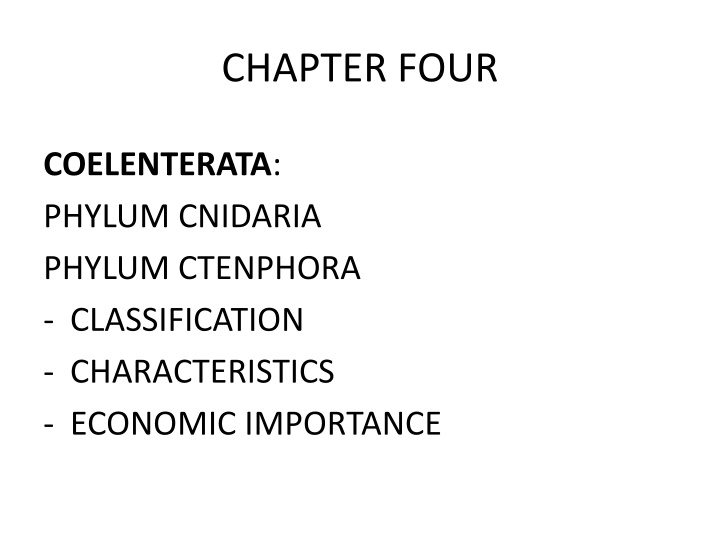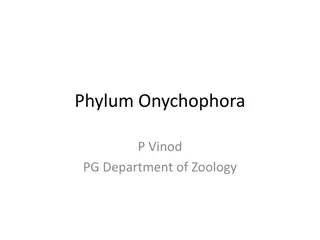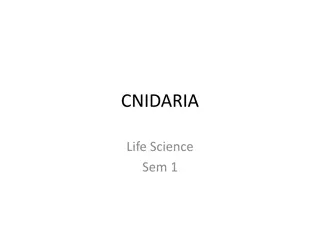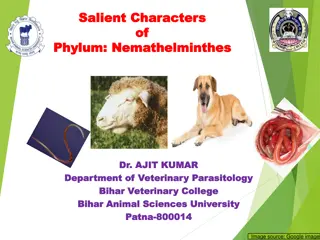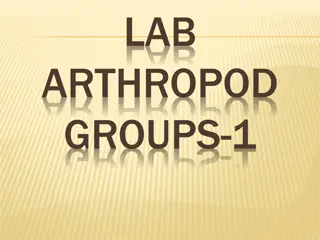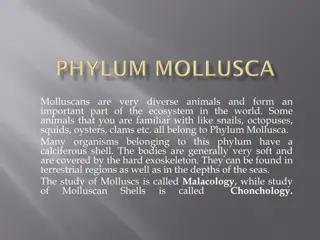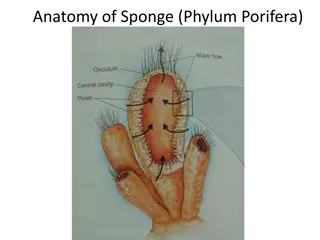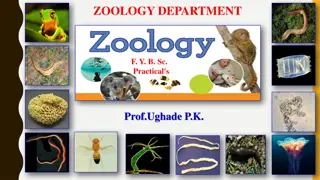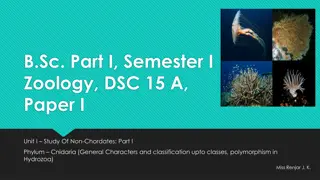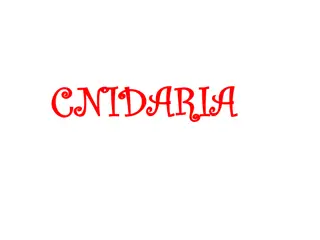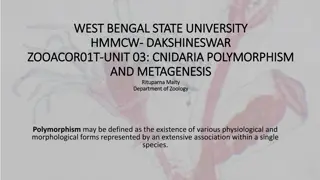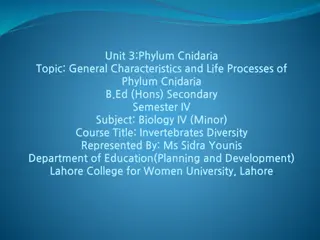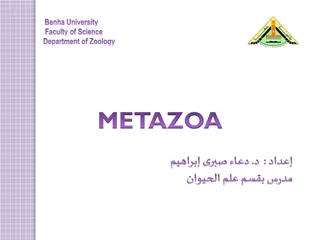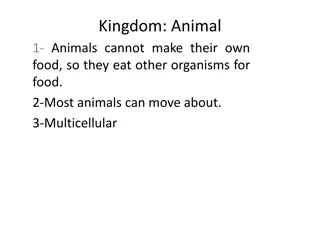Characteristics and Classification of Coelenterata: Phylum Cnidaria & Phylum Ctenophora
Coelenterata includes animals with radial symmetry, diploblastic tissues, and distinctive features like cnidocytes. The phylum comprises Cnidaria and Ctenophora, with unique tentacles, reproductive cycles, and tissue layers. Explore the vital role of these organisms in marine ecosystems and their economic significance.
Download Presentation

Please find below an Image/Link to download the presentation.
The content on the website is provided AS IS for your information and personal use only. It may not be sold, licensed, or shared on other websites without obtaining consent from the author.If you encounter any issues during the download, it is possible that the publisher has removed the file from their server.
You are allowed to download the files provided on this website for personal or commercial use, subject to the condition that they are used lawfully. All files are the property of their respective owners.
The content on the website is provided AS IS for your information and personal use only. It may not be sold, licensed, or shared on other websites without obtaining consent from the author.
E N D
Presentation Transcript
CHAPTER FOUR COELENTERATA: PHYLUM CNIDARIA PHYLUM CTENPHORA - CLASSIFICATION - CHARACTERISTICS - ECONOMIC IMPORTANCE
SUPER PHYLUM COELENTERATA These are animals with definite shape; radial symmetry. They have tissues; tissues formation start from here. They are therefore, eumatozoans. They have organ formation. They have sensory organs. They have 2 types; cnidaria and ctenophora
3 They are above poriferans in the hierarchical order of development. They have double-cell layered tissues, and referred to as diploblastic organisms. An outer ectodermis and inner endodermal layers, with a gelly mesogloea in the middle. The organisms have a central lumen called coelenteron in which water gathers before being sieved for food substances. Its also, referred to as gastrovascular cavity.
4 They have circu-moral tentacles around their mouth-part. Possess special cells in the ectodermal layer called cnidocytes. These contain stinging organelles (nematocysts); They are polymorphic; polyps & medusoids. Polyps are benthic or solitary while medusoids are pelagic. They undergo asexual (buddings) &sexual reproductions.
TISSUES They are diploblastic; outer ectoderm layer with 5 types of cells, a middle gelly mesogloea that contains food materials , skeletal substances and amoeboid cells, an inner endodermal layer (gastrodermis) with 4 cell types.
7 ECTODERMAL CELL LAYERS; epithelio-muscular cells, interstitial cells, cnidocytes, mucous gland cells, nerve cell (sensory cell) ENDODERMAL LAYER CELLS; gland cells, mucous secreating cells, nutritive muscle cells, cnidocytes
nematocysts nematocysts are also referred to as cnidae. 3 types of cnidae; - Nematocysts proper - Spirocysts - ptychocysts
classification Kingdom Animalia Subkingdom - Metazoa 2 Branch - Parazoa & Eumatozoa Grade - Bilateria & Radiata Super-phylum Coelenterata Phylum- Cnidaria & Ctenophora
Phylum Cnidaria Has 4 Classes; Anthozoa, Hydrozoa, Scyphozoa & Cubozoa Anthozoa has 3 subclasses and 15 orders. Hydrozoa has no subclass but 9 orders. Scyphozoa has no subclass but 4 orders Cubozoa has no subclass but 1 order
1. Class Anthozoa Has 3 subclasses; Zoantharia , Ceriantipatheria & Alcyonaria (octocorallia). Has 6000 sp. Mostly hydroids. - Zoantharia also known as Hexacorallia or hard corrals has 5 orders; Zoanthinaria, Actinaria, Scleractinia, Corallimorpharia, Ptychoactiaria. Eg. Taelia (sea anemones), Acroponema,
13 - Alcyonaria is also referred to as Octocorallia or horny corrals has 8 Orders ; Stolonifera, Gastraxonacea, Telestacea, Protoalcyonaria, Gorgonacea, Alcyonacea, Coenothecalia, Penantulacea. Eg. Tubiposa, Gorgonia, Alcyonia, etc. - Ceriantipatheria; thorny corrals has 2 Orders; Antipatharia & Ceriantharia. Eg. Cerianthes, Antipathes, Stichopathes
14 2. Class HYDROZOA Has no subclass but has 9 Orders; Thecata, Athecata, Actinulida, Limnomedusae, Trachylina, Millesporina, Siphonophora, Chondrophora, Stylosterina . It has 2700 species. They are polymorphic 3. Class CUBOZOA Has no subclass but 1 Order; Cubomedusae
15 4. Class Scyphozoa ; Has no subclass 4 Orders; Caronatae, Rhizostomeae, Stauromedusae, Semaeostomeae. Eg. Aurelia (jellyfish), Cassiopeia, Rhizostoma, Cyanea, etc. There are 200 species. medusoid stage is prominent
PHYLUM CTENOPHORA This phylum contains less than 100 species. They are all marines They approach bilateral symmetry. They have 8 rolls of comb-like plates that are used for locomotion. Most are free- swimmers with few being benthic They have 2 pair of tentacular sheath
19 Surfaces of the 8 plates are fused. And have glue like cells called COLLOBLAST. They have complex gastro-vascular system; stomach, pharynx, pouches and canals.
20 Animals have nerve nets system; nerve cells (ocelli) and balancing cells (statocysts) They are monoecious; have both testis and ovaries. Sperms are shed into water, etc. Animals are transparent and give lights in the dark
classification Phylum Ctenophora has 2 Classes; Tentaculata & Nuda Class Nuda has 1 Order; Beroidea Class tentaculata has 6 Orders; Lobata, Cessida, Ganishida, Plactyctida, Thalassocalycida. Eg. Pleurobranchia, Mnemiopsis, Cestum and Haeckelia
Economic importance They are ferocious feeders; can be used to control larval bloom. They filter salts from the sea, and deposit them on coral reefs, eg. Zooxanthella Feeding on zooplankton cause fishes to leave continental shelf into deeper sea. Dried corals are used as vases. Have protective symbiotic relations with hermit crabs
